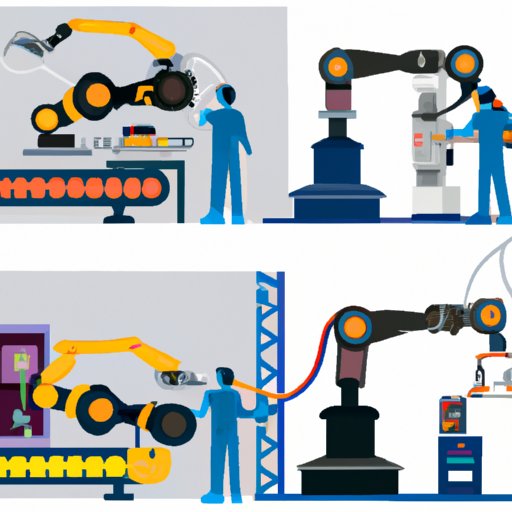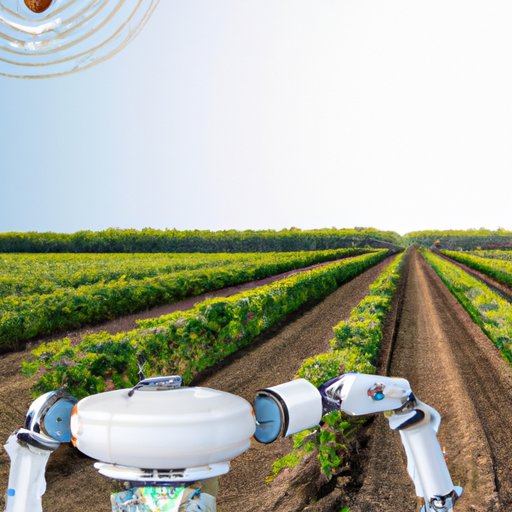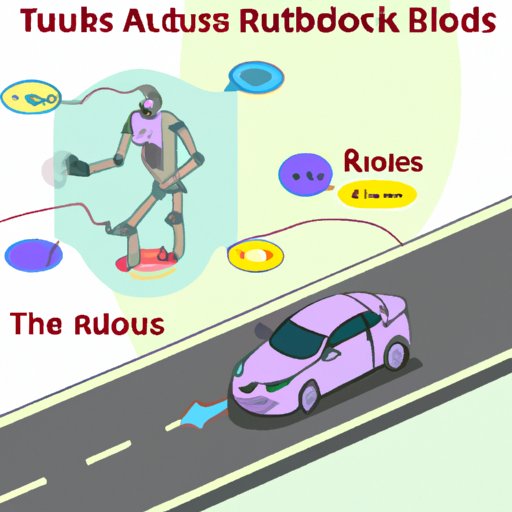Introduction
Robotics is an ever-evolving field that has been gaining traction in recent years. A robot is a machine designed to carry out a complex series of actions automatically, usually following a set of programmed instructions. They are typically used for repetitive tasks, such as manufacturing and assembly line work, but can also be used for more complex tasks, such as medical procedures and transportation. In this article, we’ll explore the different types of robots used today and their various applications.

Exploring the Different Types of Robots Used in Industry
Robots have been used in industry for decades, primarily in manufacturing and assembly line work. Industrial robots are typically large machines that are used to automate repetitive tasks, such as welding, painting, and packaging. According to a study by the International Federation of Robotics, “the automotive industry is the largest user of industrial robots, accounting for around 40% of all robot installations.”
In addition to industrial robots, there are a growing number of service robots being used in industry. These robots are typically smaller and more agile than industrial robots, and are used for tasks such as cleaning, security, and delivery. For example, the autonomous mobile robots (AMRs) manufactured by Fetch Robotics are used for material transport and inventory management in warehouses and fulfillment centers.
Robots are also being used in the medical field. Medical robots are typically used for less invasive surgical procedures, such as laparoscopic surgery. They can also be used for diagnostic purposes, such as imaging and biopsy. According to a study by the National Center for Biotechnology Information, “robotic systems offer advantages over traditional surgical methods, including increased precision, reduced invasiveness, and improved outcomes.”
How Artificial Intelligence is Changing the Way We Interact with Robots
As robots become increasingly sophisticated, they are becoming more adept at understanding human language and responding appropriately. This is thanks to advances in artificial intelligence (AI), which enables robots to better interpret and respond to human commands. AI-enabled robots are also able to make autonomous decisions based on data they collect from their environment. For example, a robot may be able to detect obstacles in its path and adjust its route accordingly.
Natural language processing (NLP) is a form of AI that enables robots to understand and respond to natural language commands. This is especially helpful for robots that interact with humans, such as home assistants and customer service bots. NLP makes it possible for robots to accurately interpret human commands and respond appropriately.
Autonomous decision making is another form of AI that enables robots to make decisions without human input. This is particularly useful for robots that are designed to operate independently, such as self-driving cars. Autonomous decision making gives robots the ability to make real-time decisions based on data they receive from their environment.
Robotics in Education: Teaching Kids About Technology and Engineering
Robotics is not just about industry and automation; it is also about teaching kids about technology and engineering. Robotics programs in schools teach students how to design, build, and program robots. This helps them develop problem-solving skills, critical thinking, and creativity. Robotics clubs and competitions are also popular in many schools, giving students the opportunity to work together to build and program robots.
STEM (Science, Technology, Engineering, and Math) programs in schools are also utilizing robotics to teach students about technology and engineering. These programs give students the opportunity to learn about robotics and coding in a hands-on setting. They are also beneficial for students who may not be interested in traditional academic subjects, as they provide an engaging and fun way to learn.
The Future of Automation: What Role Will Robots Play?
Automation is rapidly becoming more prevalent in many industries, and robots are playing a major role in this shift. Automation in manufacturing allows for higher production rates and greater accuracy, while reducing labor costs. Autonomous vehicles are also becoming increasingly common, with companies like Google and Tesla leading the way. Smart homes are also becoming more automated, with robots being used for tasks such as vacuuming, mowing, and cleaning.
Robots are also being used for healthcare and medical tasks. Assistive devices, such as prosthetics and exoskeletons, are becoming more advanced and able to perform increasingly complex tasks. Robotic surgery is also becoming more commonplace, with robots being used for more precise and less invasive procedures. Diagnostic tools, such as MRI and CT scanners, are also being automated, allowing doctors to quickly and accurately diagnose patients.

Robots in Agriculture: Increasing Crop Yields and Efficiency
Robots are also being used in agriculture to increase crop yields and efficiency. Automated harvesting is becoming increasingly popular, with robots being used to pick fruits and vegetables. Soil analysis robots are also being developed, allowing farmers to quickly and accurately assess soil conditions. Pest control robots are also being developed, allowing farmers to identify and eliminate pests without using pesticides.

Autonomous Cars and the Impact of Robotics on Transportation
Autonomous cars are rapidly becoming a reality, and robots are playing a major role in this transition. Self-driving cars are being developed by companies such as Google, Tesla, and Uber, and are expected to revolutionize the way we travel. Autonomous trucks are also being developed, allowing for faster and more efficient cargo delivery. Drone delivery is also becoming more popular, with companies such as Amazon and UPS exploring the potential of using drones for package delivery.
Conclusion
Robots are being used in a variety of fields and industries, from manufacturing to healthcare. They are becoming increasingly sophisticated, thanks to advances in artificial intelligence and natural language processing. Robotics is also being used to teach kids about technology and engineering, and to increase crop yields and efficiency in agriculture. Autonomous cars and drones are also becoming increasingly common, revolutionizing the way we travel.
The potential benefits of robotics are numerous, but there are also potential challenges. As robots become increasingly sophisticated, there is a risk of job displacement, as robots can take over many of the tasks that were once performed by humans. There is also the potential for misuse of robots, as they can be used for malicious or unethical purposes. However, if used responsibly, robots can be a powerful tool for improving our lives.
In conclusion, robots are becoming increasingly prevalent in our society, and their uses are only growing. They are being used for a variety of tasks, from manufacturing to healthcare, and are revolutionizing the way we interact with technology. The potential benefits of robotics are numerous, but there are also potential challenges. As robots become more sophisticated, it is important to consider the ethical implications of this technology and ensure that it is used responsibly.
(Note: Is this article not meeting your expectations? Do you have knowledge or insights to share? Unlock new opportunities and expand your reach by joining our authors team. Click Registration to join us and share your expertise with our readers.)
